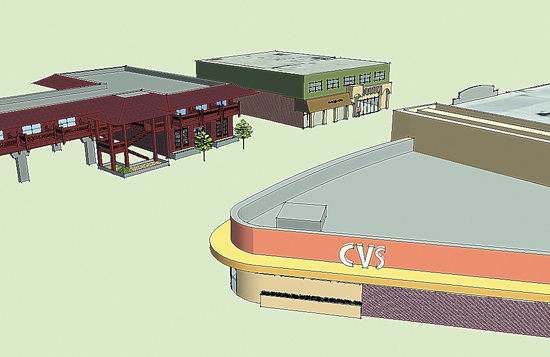 | | | One portion of the virtual model of Orinda's downtown.
Photo A. Auzers, courtesy of A. Gell and M. Wilcox
| | | | | | Teacher Aileen Gell is proud of what the students in her Architectural Design course at Miramonte High School have achieved this year. For the past several months, Gell's class has labored to produce a three-dimensional digital model of Orinda's downtown, which is now nearly 75% complete. When finished, the model could serve as an integral tool for facilitating community discussion regarding the future planning of Orinda's commercial district.
 To create the model, the students have been mentored by Orinda residents Peter Hasselman, an internationally renowned urban planner, and designer Michael Woodcox; these professionals have led lectures and discussion periods, and coached students in the use of computerized modeling tools. This unique collaboration has given the Miramonte students the opportunity to work on a real-world project, and access to expertise seldom encountered outside of the workplace.
To create the model, the students have been mentored by Orinda residents Peter Hasselman, an internationally renowned urban planner, and designer Michael Woodcox; these professionals have led lectures and discussion periods, and coached students in the use of computerized modeling tools. This unique collaboration has given the Miramonte students the opportunity to work on a real-world project, and access to expertise seldom encountered outside of the workplace.
 Both Hasselman and Woodcox are members of OrindaVision, a group which has proposed ideas for how the land- and streetscape of Orinda's Crossroads and Village might evolve in the future. According to Woodcox, OrindaVision wants to promote a dialogue in the community, to spur residents to think about the City's architectural future. The model, as a component of that goal, is intended as a sort of "conversation starter" for area residents.
Both Hasselman and Woodcox are members of OrindaVision, a group which has proposed ideas for how the land- and streetscape of Orinda's Crossroads and Village might evolve in the future. According to Woodcox, OrindaVision wants to promote a dialogue in the community, to spur residents to think about the City's architectural future. The model, as a component of that goal, is intended as a sort of "conversation starter" for area residents.
 The students' model is impressive. Produced with inexpensive software running on ordinary computer workstations, the digital replica of the city can be viewed from any angle. With a few clicks of the mouse, it's even possible to get a pedestrian's view of the downtown buildings, which sprout up on both sides of a virtual Moraga Way, proportionally-accurate and quite lifelike.
The students' model is impressive. Produced with inexpensive software running on ordinary computer workstations, the digital replica of the city can be viewed from any angle. With a few clicks of the mouse, it's even possible to get a pedestrian's view of the downtown buildings, which sprout up on both sides of a virtual Moraga Way, proportionally-accurate and quite lifelike.
 Though Gell's students, like professional designers, continue to build paste-and-paper models as well, the advantage of the digital model is its limitless, effortless mutability. The students can erect new buildings, destroy old ones, and make other modifications with a few keystrokes.
Though Gell's students, like professional designers, continue to build paste-and-paper models as well, the advantage of the digital model is its limitless, effortless mutability. The students can erect new buildings, destroy old ones, and make other modifications with a few keystrokes.
 Many of Gell's students are graduating seniors like John Krakowski, who says Architectural Design was his favorite class; he plans to attend the University of Oregon at Eugene and major in architecture. Krakowski worked with classmates to create the model's Wells Fargo building. Asked about changes he would like to see in Orinda's downtown in ten years, Krakowski said he would appreciate more businesses, noting that downtown currently "seems really underdeveloped."
Many of Gell's students are graduating seniors like John Krakowski, who says Architectural Design was his favorite class; he plans to attend the University of Oregon at Eugene and major in architecture. Krakowski worked with classmates to create the model's Wells Fargo building. Asked about changes he would like to see in Orinda's downtown in ten years, Krakowski said he would appreciate more businesses, noting that downtown currently "seems really underdeveloped."
 Gell's course is the capstone in a multi-year sequence of design instruction. Next year, new students will join veterans of the current Architectural Design program. They will all work together to complete the digital downtown model, and time and resources permitting, to assemble a physical replica.
Gell's course is the capstone in a multi-year sequence of design instruction. Next year, new students will join veterans of the current Architectural Design program. They will all work together to complete the digital downtown model, and time and resources permitting, to assemble a physical replica.

|
